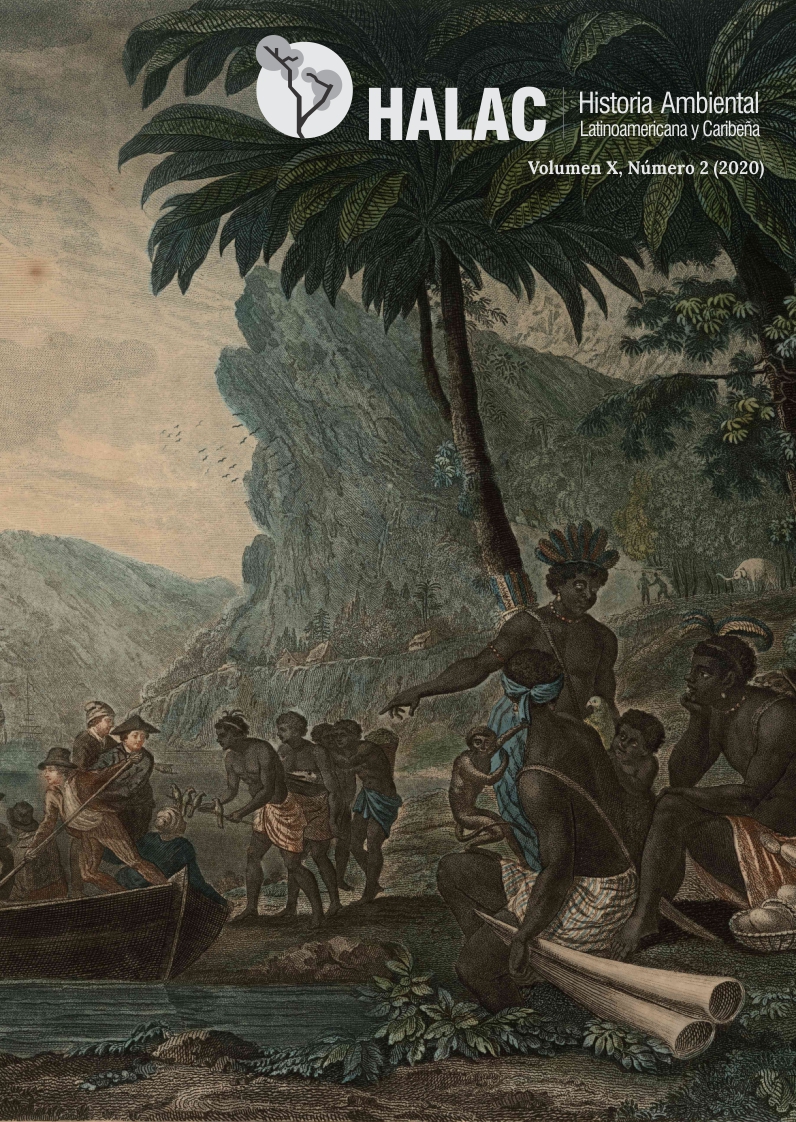Transformations of the Natural Landscape of Northern Paraná from the 1930s to the 1980s: Coffee Monoculture and the Modernization of Agriculture and its Ecological, Economic and Social Consequences
DOI:
https://doi.org/10.32991/2237-2717.2020v10i2.p255-283Keywords:
Northern Paraná, Transformations of Nature, Coffee Monoculture, Agrobusiness, Rural Exodus, Devastation of Natural ResourcesAbstract
From the 1930s to the 1980s Northern Paraná passed through a very dynamic process of landscape transformations: From forest clearing in a pioneer area via coffee monoculture to a region of diversified and modernized agriculture, controlled by soy agrobusiness. Focus of the dominant actors was rapid economic success. There were “winners” and “loosers”, regional consolidation or ecological and socioeconomic degradation. Abandonning of coffee cultivation because of frosts, agrarian modernization and expansion of extensive stock raising caused serious social problems: land concentration and dismissal of farm workers. Rural exodus took aim at new pioneer fronts in Paraguay and Amazonia or increased the urban proletariat of regional centers. Environmental awareness was missing, in view of enormous irreparable damage of wide-spread burning and extinction of biodiversity. Agrarian colonization of Northern Paraná is a fascinating example of a region with large ecological, economic and agro-social transformations within only five decades.
References
Bernardes, Lysia Maria Cavalcanti, “O problema das “frentes pioneiras” no Estado do Paraná,” Revista Brasileira de Geografia, 18, 3 (1953): 335-384.
Coy, Martin. Regionalentwicklung und regionale Entwicklungsplanung an der Peripherie in Amazonien. Tübinger Beiträge zur Geographischen Lateinamerika-Forschung (TBGL), 5 (Tübingen: Ed. Instituto de Geografia da Universidade, 1988).
Coy, Martin, Martin Klingler e Gerd Kohlhepp, ”De frontier até pós-frontier: regiões pioneiras no Brasil dentro do processo de transformação espaço-temporal e sócio-ecológico”, Confins (Revista franco-brasileira de geografia), 30 (2017): 1-48.
Dean, Warren. A ferro e fogo: a história e a devastação da Mata Atlântica brasileira (São Paulo: Cia. das Letras, 1996).
Derpsch, Rolf et al. Erosionsbekämpfung in Paraná, Brasilien. Schriftenreihe GTZ, 205 (Eschborn: GTZ, 1988).
Dutra e Silva, Sandro. No Oeste, a terra e o céu: a expansão da fronteira agrícola no Brasil Central (Rio de Janeiro: Mauad X, 2017).
França, Ari. The coffee trail and pioneer fringes (Rio de Janeiro: IGU, 1956).
IBC. Anuário Estatístico do café (Rio de Janeiro: IBC, 1964).
IBDF/Fundação de Pesquisas Florestais do Paraná. Monitoramento da cobertura florestal do Brasil. Estado do Paraná (Curitiba: IBDF, 1983).
IBGE. Censo Demográfico do Estado do Paraná, 1970, 1980 (Rio de Janeiro: IBGE).
IBGE. Censo Agrícola do Estado do Paraná, 1960, 1970 (Rio de Janeiro: IBGE).
James, Preston E., “The changing patterns of population in São Paulo State, Brazil,“ Geographical Review, 28 (1938): 353-362.
Klanovicz, Jo e Lucas Mores, “A sojização da agricultura moderna no Paraná, Brasil: uma questão de história ambiental,” Fronteiras: Journal of Social, Technological and Environmental Science, 6 (2017): 240-263.
Kohlhepp, Gerd, “Planung und heutige Situation staatlicher kleinbäuerlicher Kolonisationsprojekte an der Transamazônica,“ Geographische Zeitschrift, 64, 3 (1976): 171-211.
Kohlhepp, Gerd, “Estratégias de desenvolvimento regional na Amazônia Brasileira”, Finisterra (Lisboa), 16, 31 (1981): 63-94.
Kohlhepp, Gerd, “Development planning and practices of economic exploitation in Amazonia. Recent trends in spatial organization of a tropical frontier region in Brazil (1966-1981),“ In The Amazon. Limnology and landscape ecology of a mighty tropical river and its basin, Monographiae Biologicae, 6, ed. Harald Sioli (Dordrecht, Boston, Lancaster: Dr.W.Junk Publishers, 1984): 649- 674. (a)
Kohlhepp, Gerd, “Colonización y desarrollo dependiente en el oriente Paraguayo,” Revista Geográfica (México), 99 (1984): 5-33. (b)
Kohlhepp, Gerd, “A emigração brasileira para o leste do Paraguai. Uma análise das causas, evolução e consequências,” In Desarrollo demográfico, migraciones y urbanización en América Latina, Eichstätter Beiträge, 17, Abt. Lateinamerika 1, eds. Dieter W.Benecke et al. (Regensburg: Friedrich Pustet, 1986): 207- 224.
Kohlhepp, Gerd, “Landnutzungs-Sukzessionen im nördlichen Paraná (Südbrasilien)“. Freiburger Geographische Hefte, 30 (Freiburg: Ed. Instituto de Geografia Física da Universidade, 1990): 45-68.
Kohlhepp, Gerd, „Mudanças estruturais na agropecuária e mobilidade da população rural no Norte do Paraná (Brasil),” Revista Brasileira de Geografia, 53, 2 (1991): 79-84.
Kohlhepp, Gerd. Colonização agrária no Norte do Paraná (Maringá: EDUEM, 2014; original em alemão: Agrarkolonisation in Nord-Paraná, Wiesbaden: Franz Steiner Verlag, 1975).
Loeb Caldenhof, Ricardo. Memoiren (Rolândia: versão original: São Paulo: Instituto Martius Staden, 1997).
Maack, Reinhard. Geografia física do Estado do Paraná (Curitiba: Max Roesner Ltda., 1968).
Monbeig, Pierre. Pionniers e planteurs de São Paulo (Paris: A.Colin, 1952).
Rego, Renato Leão, “A tropical enterprise: British planning ideas in a private settlement in Brazil”, Planning Perspectives, 26, 2 (2011): 261-282.
SEAG. Análise econômica do sistema de manejo do solo em plantio direto (Curitiba: SEAG, 1981).
Taylor, John A., “New Brazilians set the pace in Paraná“, The Geographical Magazine, 44, 6 (1972): 420-423.
Waibel, Leo, ”As zonas pioneiras do Brasil,” Revista Brasileira de Geografia, 17, 4 (1955): 389-422.
Downloads
Published
How to Cite
Issue
Section
License
This journal offers immediate free access to its content, following the principle that providing free scientific knowledge to the public provides greater global democratization of knowledge.
As of the publication in the magazine the authors have copyright and publication rights of their articles without restrictions.
The HALAC Magazine follows the legal precepts of the Creative Commons - Attribution-Non-Commercial 4.0 International license. 




